If you’re obsessed with pickles and love the fresh crunch of pico de gallo, get ready to meet your new favorite obsession. Pickle de Gallo combines the tangy, briny goodness of dill pickles with the vibrant freshness of traditional Mexican salsa, creating a flavor explosion that’s taken social media by storm in 2025.
This addictive pickle salsa first gained popularity thanks to Grillo’s Pickles, but why settle for store-bought when you can create an even better version at home? Our homemade Pickle de Gallo recipe delivers maximum crunch, bold flavor, and endless customization possibilities – all while saving you money and avoiding unnecessary preservatives.
In this comprehensive guide, you’ll discover the secrets to crafting the perfect Pickle de Gallo that rivals any commercial version. We’ll walk you through selecting the best ingredients, mastering the ideal texture balance, and exploring creative serving suggestions that go far beyond basic tortilla chips. Plus, you’ll get insider tips for meal prep, storage optimization, and troubleshooting common issues that even experienced home cooks face.
What is Pickle de Gallo? (The Pickle Lover’s Dream Salsa)
Pickle de Gallo is essentially a pickle lover’s twist on traditional pico de gallo, replacing tomatoes with diced dill pickles while keeping all the fresh, crunchy vegetables that make salsa irresistible. This ingenious creation transforms the classic Mexican condiment into a tangy, briny sensation that’s become a viral food trend across the United States.
The concept was popularized by Grillo’s Pickles, a Boston-based company that recognized pickle enthusiasts needed more ways to satisfy their cravings beyond eating pickles straight from the jar. What started as a specialty product has evolved into a home kitchen staple, with countless variations appearing across social media platforms and food blogs.
Unlike traditional pico de gallo, which relies on tomatoes for its base and mild acidity, Pickle de Gallo uses diced dill pickles as the star ingredient. This substitution creates a more intense flavor profile – think of it as pico de gallo’s bold, rebellious cousin. The pickles provide that signature tang and satisfying crunch, while fresh vegetables like cucumber, red bell pepper, and red onion add color, texture, and complementary flavors.
The texture is what sets Pickle de Gallo apart from other pickle-based dishes. Each bite delivers multiple layers of crunch – from the firm pickles to the crisp cucumber and pepper pieces. The pickle brine acts as a natural dressing, eliminating the need for additional oils or vinegars while infusing every component with that beloved pickle flavor.
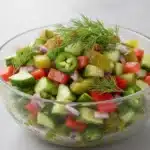
Ultimate Pickle de Gallo
Equipment
- – Cutting board
- chef’s knife
- Mixing bowl
- mixing spoon
- slotted spoon
- storage container with lid
Ingredients
- 2 cups diced refrigerated dill pickles
- 1 cup diced English cucumber (seeds removed)
- 1 cup diced red bell pepper
- 1/2 cup finely diced red onion
- 1 jalapeño, seeded and minced (adjust to taste)
- 2 cloves fresh garlic, minced
- 3 tbsp pickle brine (more to taste)
- 2 tbsp fresh dill, chopped
- 1 lime, juiced (optional)
- 1 pinch kosher salt (optional, to taste)
Instructions
- Dice all vegetables and pickles into uniform ¼-inch cubes for even flavor and crunch. Pat pickles dry to reduce excess moisture.
- In a large mixing bowl, combine diced pickles, cucumber, red bell pepper, and red onion. Add minced garlic and jalapeño.
- Pour pickle brine over the mixture and fold gently to coat. Add chopped dill, lime juice, and salt if needed. Stir carefully to avoid crushing vegetables.
- Cover and refrigerate for at least 2 hours (overnight for best flavor). Stir before serving to redistribute juices.
- Serve with tortilla chips, tacos, burgers, or as a topping for meats and salads. Drain excess liquid with a slotted spoon before plating.
Notes
Essential Ingredients for Perfect Pickle de Gallo
Creating the ultimate Pickle de Gallo starts with selecting the right ingredients. While the recipe is refreshingly simple, each component plays a crucial role in achieving that perfect balance of crunch, tang, and freshness that makes this pickle salsa so addictive.
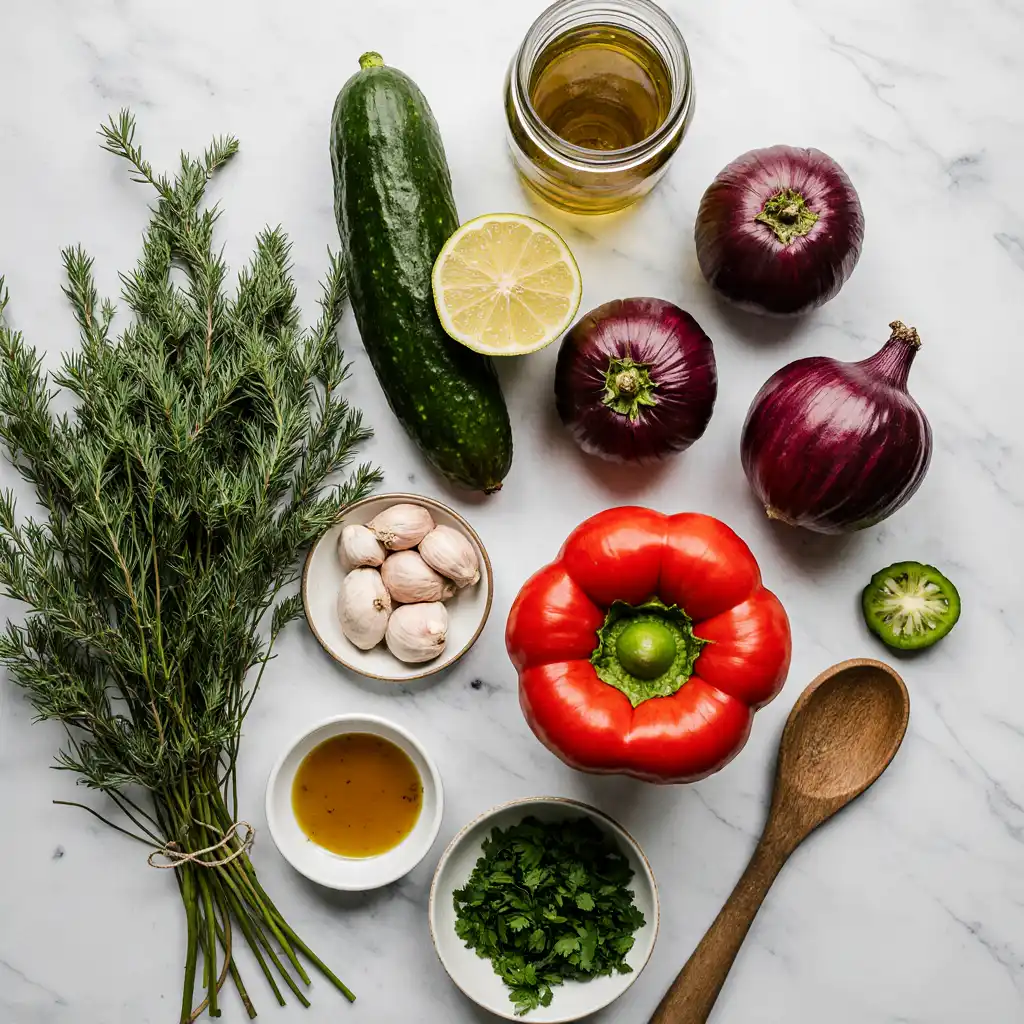
The Star Players
Dill Pickles form the foundation of your Pickle de Gallo, so quality matters immensely. Refrigerated dill pickles like Grillo’s, Claussen, or Bubbies deliver superior crunch and flavor compared to shelf-stable varieties. Look for pickles with minimal ingredients – cucumbers, water, vinegar, salt, garlic, and dill should be the primary components. Baby kosher dill pickles work beautifully because they’re easy to dice uniformly, but full-size pickles work equally well when chopped properly.
Fresh Cucumber provides essential texture contrast and helps balance the pickle’s intensity. English (seedless) cucumbers are your best choice because their thin skin doesn’t require peeling, and they have fewer seeds to remove. Persian cucumbers work wonderfully too. Always slice lengthwise and gently scrape out the seed cavity with a spoon to prevent excess liquid from diluting your salsa.
Red Bell Pepper contributes natural sweetness and vibrant color that makes Pickle de Gallo visually appealing. Red peppers are significantly sweeter than green varieties, creating better flavor harmony with the tangy pickles. Choose firm, glossy peppers without soft spots for optimal crunch retention.
The Supporting Cast
Red Onion adds sharp bite and beautiful color contrast, though sweet onions like Vidalia create a milder profile if you prefer less aggressive onion flavor. For those sensitive to raw onion, soak diced pieces in cold water for 30 minutes before adding to reduce intensity while maintaining crunch.
Fresh Jalapeño provides customizable heat levels. Remove seeds and membranes for mild warmth, or include them for more intensity. Pickled jalapeños can substitute fresh ones for extra tang, while habanero peppers add serious heat for spice enthusiasts.
Fresh Garlic is non-negotiable for authentic flavor. Minced raw garlic infuses every bite with aromatic intensity that complements the dill perfectly.
The Flavor Enhancers
Pickle Brine is the secret ingredient that transforms ordinary chopped vegetables into cohesive Pickle de Gallo. Use brine from your pickle jar – it’s already perfectly seasoned and eliminates the need for additional vinegar or complex dressing.
Fresh Dill reinforces the pickle flavor while adding herbal brightness. Dried dill can substitute in a pinch, but fresh delivers superior flavor impact.
Lime Juice is optional but recommended for those who enjoy citrus brightness balancing the pickle’s acidity.
Step-by-Step Pickle de Gallo Recipe
Creating perfect Pickle de Gallo requires attention to detail during preparation, but the actual process is surprisingly simple. Following these precise steps ensures optimal texture, flavor balance, and that irresistible crunch that makes this pickle salsa so addictive.
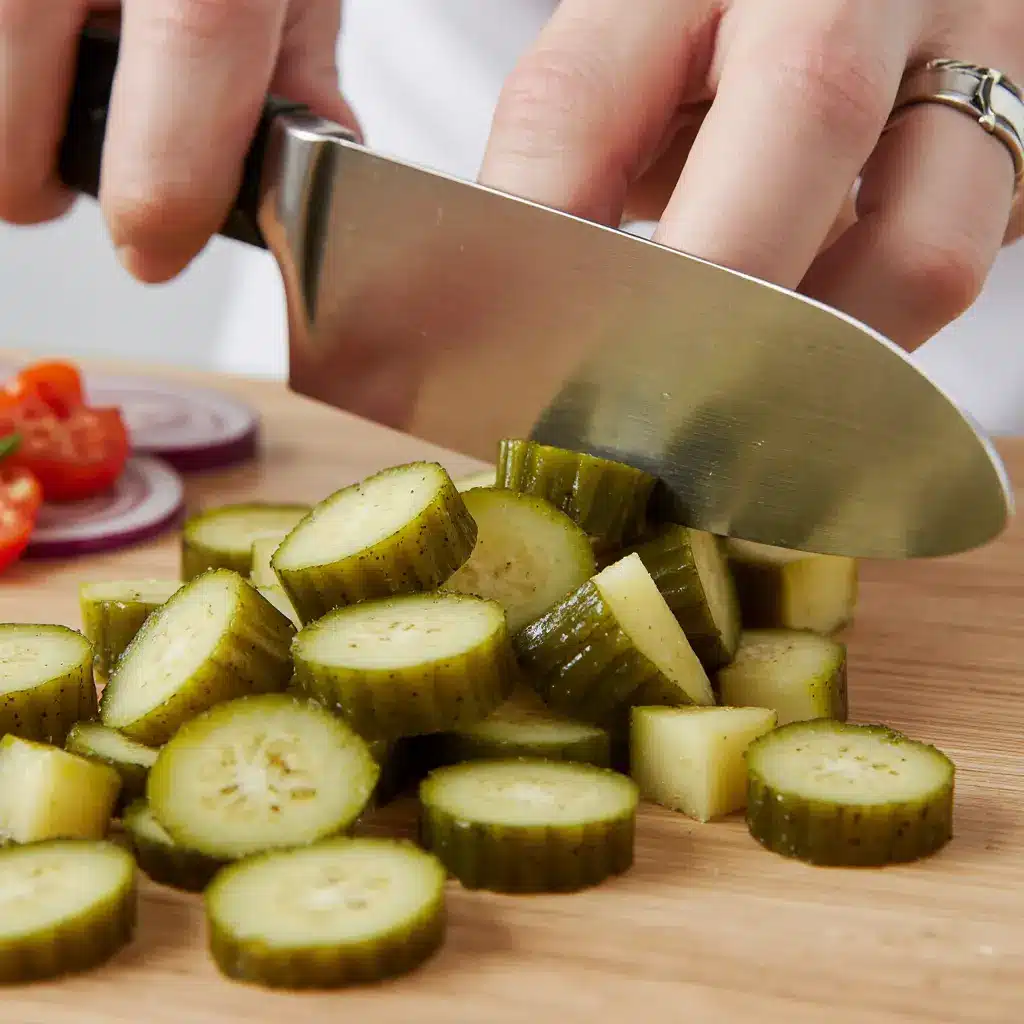
Prep Work (5 minutes)
Proper dicing technique is crucial for achieving restaurant-quality results. Start by dicing all vegetables into uniform ¼-inch pieces – consistency ensures every bite delivers balanced flavors and textures. Begin with your dill pickles, cutting them lengthwise into strips, then crosswise into small cubes. Pat diced pickles gently with paper towels to remove excess surface moisture.
Prep your fresh cucumber by slicing lengthwise and gently scraping out the seed cavity with a spoon. This prevents excess water from diluting your finished salsa. Dice the cucumber flesh into pieces matching your pickle size.
For the red bell pepper, remove the stem, seeds, and white membranes completely before dicing. Seeds add unwanted bitterness, while uniform pieces ensure even flavor distribution.
Dice the red onion finely – smaller pieces integrate better and provide flavor without overwhelming individual bites. For those sensitive to raw onion bite, soak diced pieces in ice water for 15 minutes, then drain and pat dry.
Assembly and Mixing (5 minutes)
Mixing order matters for optimal flavor development. In a large mixing bowl, combine the diced pickles first, followed by cucumber, red bell pepper, and onion. Add minced garlic and diced jalapeño last to prevent them from settling at the bottom.
Pour pickle brine over the vegetables slowly while gently folding the mixture with a large spoon. The brine should lightly coat all ingredients without creating a soupy consistency. Start with 2-3 tablespoons of brine and add more gradually if needed – you can always add more, but you can’t take it away.
Sprinkle fresh dill and a pinch of kosher salt over the mixture. Remember that pickles and pickle brine already contain significant sodium, so taste before adding extra salt. Fold everything together gently to avoid crushing the vegetables.
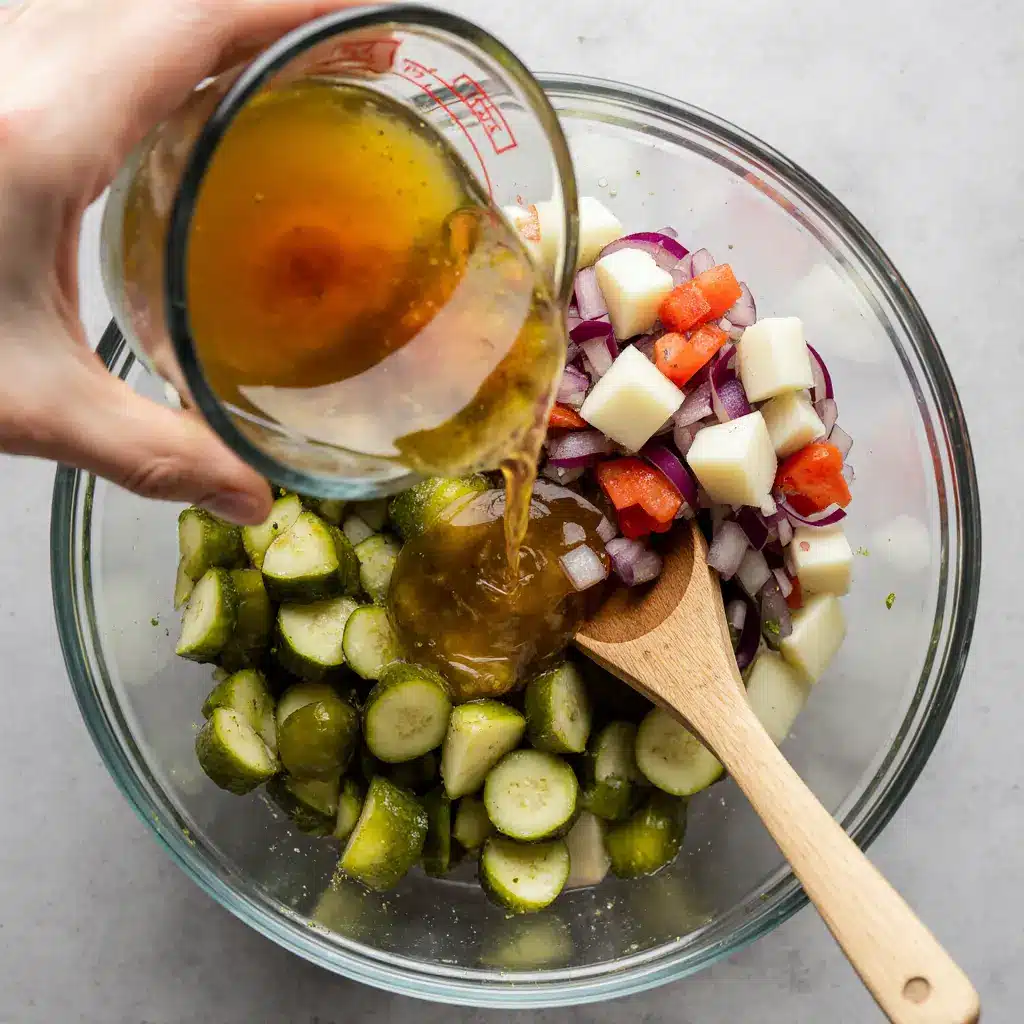
Marinating for Maximum Flavor (2+ hours)
Marinating is non-negotiable for developing the complex flavors that separate homemade Pickle de Gallo from hastily thrown-together versions. Cover your bowl tightly with plastic wrap or transfer the mixture to an airtight container.
Refrigerate for at least 2 hours, but overnight marination produces superior results. During this time, the vegetables release natural juices that combine with the pickle brine to create a flavorful liquid that enhances every component.
Before serving, give the mixture a thorough stir to redistribute the accumulated juices from the bottom. Taste and adjust seasoning if necessary – you might want additional pickle brine, a squeeze of fresh lime juice, or a pinch more salt depending on your preferences.
The finished Pickle de Gallo should be vibrant, crunchy, and intensely flavorful with a balanced sweet-tangy profile that makes it impossible to stop eating.
Pro Tips for the Best Pickle de Gallo
Mastering Pickle de Gallo goes beyond following a basic recipe. These professional techniques, gathered from testing dozens of variations and analyzing what separates good from exceptional results, will elevate your pickle salsa from amateur to restaurant-quality.
Ingredient Quality Selection
Always choose refrigerated pickles over shelf-stable varieties for superior crunch and flavor intensity. Refrigerated pickles like Grillo’s, Claussen, or Bubbies maintain their crisp texture and deliver that signature snap in every bite. Shelf-stable pickles often become soft and mushy once mixed with other ingredients, ruining the textural contrast that makes Pickle de Gallo special.
Select firm, fresh vegetables exclusively – soft or aging produce will compromise the entire batch’s texture. Press each cucumber and bell pepper gently; they should feel solid without any give. Avoid vegetables with wrinkled skin or soft spots, as these indicators signal cellular breakdown that leads to mushy results.
Use kosher dill pickles as your foundation unless specifically creating a sweet or spicy variation. The balanced acidity and traditional dill seasoning in kosher varieties complement fresh vegetables perfectly, while sweet pickles can make the mixture cloying and spicy pickles may overpower delicate flavors.
Texture Optimization
Dice all ingredients into uniform ¼-inch pieces for professional presentation and consistent flavor in every bite. Uneven chopping creates an amateur appearance and results in some bites being overwhelmingly pickle-forward while others lack the signature tang.
Food processor shortcut with caution: Pulse ingredients briefly in 2-3 second bursts, checking consistency frequently to avoid over-processing. The goal is uniform chopping, not puree. Remove any large pieces manually rather than continuing to pulse, which risks turning everything mushy.
Flavor Balance Techniques
Taste before adding salt – this cannot be emphasized enough. Pickles and pickle brine already contain significant sodium, and additional salt can quickly make your Pickle de Gallo inedibly salty. Start with no added salt, taste after marinating, then adjust incrementally if needed.
Balance overly salty mixtures by adding fresh lime juice, extra diced cucumber, or a small amount of fresh bell pepper rather than diluting with water. These ingredients maintain the intended texture while neutralizing excess sodium naturally.
Make-Ahead Strategies
Marinate overnight for superior flavor development. Like traditional pico de gallo, Pickle de Gallo improves dramatically with time as ingredients release natural juices that blend with pickle brine. The 2-hour minimum is functional, but 8-24 hours creates depth that separates homemade from store-bought versions.
Drain excess liquid before serving using a slotted spoon or fine-mesh strainer. Accumulated juices can make chips soggy and dilute the concentrated flavors you’ve worked to develop. Reserve the drained liquid – it makes an excellent marinade for grilled vegetables or meat.
Double recipes for entertaining since Pickle de Gallo disappears quickly at parties. The preparation time is identical whether making one batch or three, and leftovers store beautifully for up to five days, actually improving in flavor over time.
These professional techniques transform a simple chopped pickle mixture into an addictive, restaurant-quality condiment that consistently impresses guests and family alike.
Nutritional Benefits and Information
Pickle de Gallo offers impressive nutritional advantages that make it an excellent choice for health-conscious snackers and those following various dietary plans. Unlike many condiments and salsas loaded with added sugars and preservatives, this pickle-based salsa delivers maximum flavor with minimal calories while providing surprising health benefits.
Complete Nutritional Breakdown
Based on Grillo’s commercial version and adjusted for typical homemade serving sizes, a ½-cup serving of Pickle de Gallo contains approximately 20 calories, 0 grams of fat, 4 grams of carbohydrates, and 640mg of sodium. The sodium content, while significant, comes primarily from the natural fermentation process and pickle brine rather than added table salt, making it more beneficial than artificially salted foods.
The fresh vegetables contribute essential vitamins and minerals that complement the fermented pickle benefits. Red bell peppers provide vitamin C and beta-carotene, while cucumber adds potassium and vitamin K. Fresh garlic and onion contribute antioxidants and natural antibacterial compounds that support overall health.
Key Nutritional Benefits of Pickle de Gallo
Health Benefits of Fermented Foods
Fermented pickles in quality Pickle de Gallo provide probiotics that support digestive health and may improve gut microbiome diversity. Research shows that fermented vegetables can help with digestion, reduce chronic inflammation, and potentially support immune function through beneficial bacteria that survive the stomach’s acidic environment.
The vinegar content in pickle brine offers additional health benefits, including blood sugar regulation and appetite control. Studies suggest that vinegar consumption may help stabilize glucose levels after meals, making Pickle de Gallo a smart choice for those managing diabetes or prediabetes.
Low-calorie density makes Pickle de Gallo ideal for weight management programs. The high water content and fiber from fresh vegetables help promote satiety, while the intense flavor satisfies cravings that might otherwise lead to overeating higher-calorie snacks.
Antioxidant Properties
The combination of fermented pickles and fresh vegetables creates a powerful antioxidant profile. Cucumbers contain beta-carotene, which the body converts to vitamin A, supporting eye health and immune function. The fermentation process may actually enhance the bioavailability of these antioxidants, making them more easily absorbed by the body.
Flavonoids and phenolic compounds from the vegetable mixture help combat oxidative stress and may reduce the risk of chronic diseases. Regular consumption of fermented vegetables has been linked to lower blood pressure, improved cholesterol profiles, and enhanced metabolic health in several studies.
This nutritional profile makes Pickle de Gallo more than just a tasty snack – it’s a functional food that can support various health goals while satisfying cravings for bold, tangy flavors.
Serving Suggestions: Beyond Basic Chips
While Pickle de Gallo is absolutely irresistible with classic tortilla chips, limiting this versatile condiment to just chip-and-dip duty means missing out on countless creative applications. This tangy, crunchy salsa elevates everything from quick weeknight dinners to weekend barbecues, transforming ordinary meals into flavor-packed experiences.
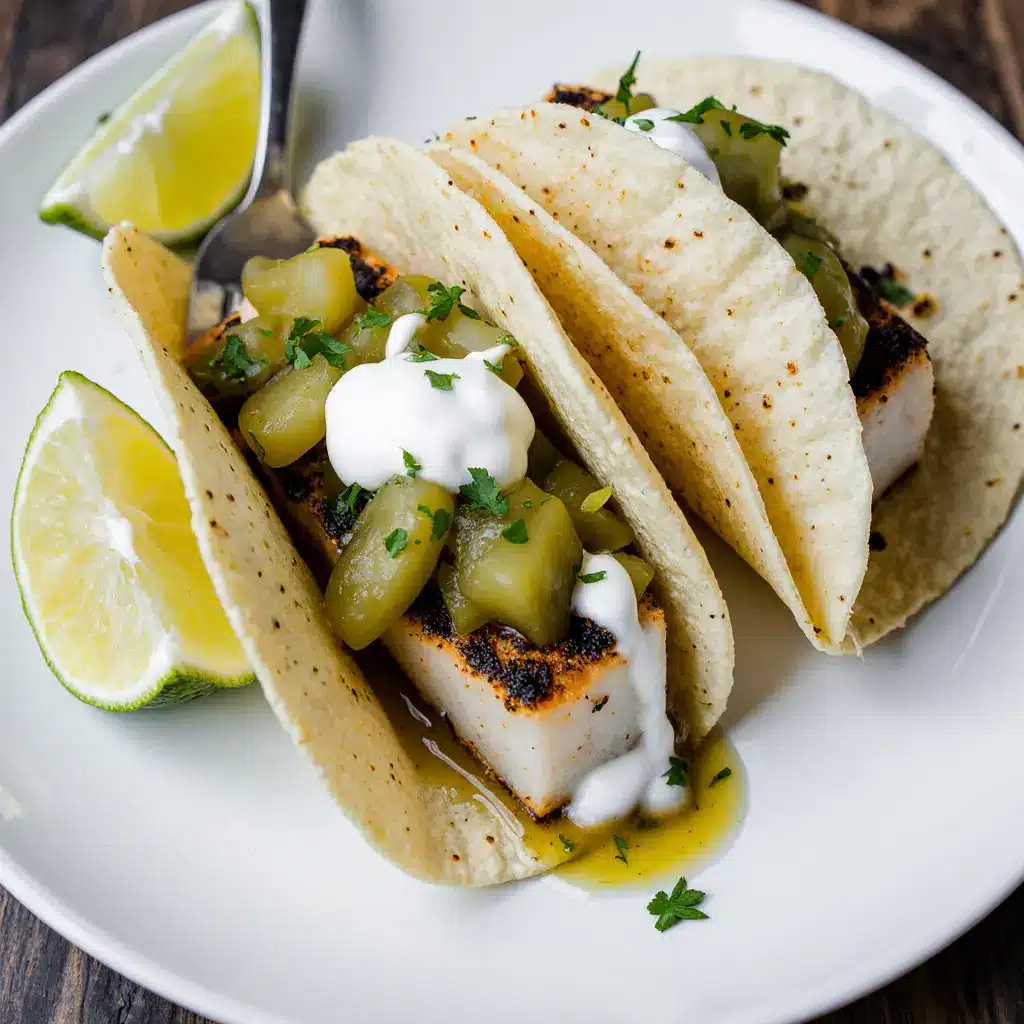
Classic Pairings
Tortilla chips remain the gold standard for Pickle de Gallo serving, but chip selection matters. Thick, sturdy tortilla chips like Tostitos Scoops or restaurant-style rounds can handle the chunky texture and liquid content without breaking. For a healthier twist, baked corn chips or blue corn varieties provide nutty flavor that complements the pickle tang beautifully.
Vegetable dippers offer nutritious alternatives while maintaining that satisfying crunch factor. Fresh strips, cucumber rounds, and celery sticks create a double-vegetable experience that pickle enthusiasts adore. Pretzel chips and sturdy crackers also work wonderfully for those wanting more substantial bases.
Creative Serving Ideas
| Serving Idea | Description |
|---|---|
| Tortilla Chips | The classic pairing for dipping and snacking |
| Tacos | Spoon over beef, chicken, or fish tacos for a zesty, crunchy twist |
| Pulled Pork Sandwiches | Brightens up pulled pork with a tangy contrast to rich meat |
| Grilled Chicken | Use as a topping for grilled chicken to add acidity and texture |
| Hot Dogs or Bratwurst | Replace traditional relish with Pickle de Gallo for bold flavor |
| Salads | Stir in or top fresh salads for added crunch and zest |
| Burgers and Sandwiches | Use as a flavorful condiment in place of traditional relish or salsa |
| Grilled or Fried Meat | Serves as a refreshing side or topping to complement meats |
| Bean Salad | Mix into black beans or black-eyed peas for instant flavorful bean salad |
| Charcuterie Board | Serve alongside cheeses and crackers for a tangy addition |
Mexican and Tex-Mex applications showcase Pickle de Gallo’s versatility perfectly. Beyond tacos, try spooning it over breakfast burritos, quesadillas, or nachos for an unexpected flavor boost. The pickle brine acts as a natural acidic balance to rich, cheesy dishes, while the vegetable crunch adds textural interest that keeps every bite engaging.
Sandwich enhancement transforms ordinary lunch fare into gourmet experiences. Mix equal parts Pickle de Gallo with mayonnaise to create an instant pickle sandwich spread that elevates everything from turkey clubs to BLTs. This combination works particularly well with grilled or fried fish, where the pickle tang cuts through any richness while adding fresh vegetable notes.
Protein pairing opportunities extend far beyond basic applications. Grilled salmon, blackened fish, or pan-seared chicken benefit enormously from Pickle de Gallo’s bright acidity. The condiment’s natural saltiness means you can reduce seasoning on the protein itself, letting the pickle salsa provide all the flavor complexity needed.
Party and entertaining applications make Pickle de Gallo a host’s secret weapon. Serve it as part of a pickle-themed charcuterie board alongside aged cheddar, salami, and artisanal crackers. For casual gatherings, set up a DIY taco or slider bar with Pickle de Gallo as one of several toppings – guests consistently gravitate toward its unique flavor profile.
Creative fusion ideas push Pickle de Gallo into unexpected territory. Try it as a pizza topping after baking, mixed into tuna or chicken salad, or even stirred into potato salad for a German-inspired twist. These applications prove that once you start thinking creatively, the possibilities become endless.
The key to successful Pickle de Gallo serving lies in understanding its role as both condiment and salad – it’s substantial enough to stand alone as a side dish but flavorful enough to enhance any main course it accompanies.
Troubleshooting Common Issues
- Too Salty
- Texture Too Soft or Mushy
- Start with refrigerated‐section pickles (Grillo’s, Claussen, Bubbies) for maximum crunch.
- Dice all vegetables into uniform ¼-inch pieces; over-processing in a food-processor or marinating longer than 24 hours breaks down texture.
- Never freeze Pickle de Gallo—ice crystals rupture cell walls and create mush.
- Vegetables Too Large or Uneven
- Excess Liquid Separates
- Flavor Falls Flat
- Add 1 tbsp fresh pickle brine at a time, tasting between additions. The brine’s vinegar and salt lift dull flavors instantly.
- Stir in fresh dill or minced garlic if the salsa has been refrigerated more than three days; herbs and aromatics lose punch over time.
With these quick fixes, you can revive or perfect any batch of Pickle de Gallo—no need to toss a tangy masterpiece!
Frequently Asked Questions
What type of pickles are best for Pickle de Gallo?
Kosher dill pickles strike the ideal balance of tang and crunch, making them the go-to option. If you want to experiment, sweet or spicy pickles also work for fun flavor variations.
Can I freeze Pickle de Gallo?
Freezing isn’t recommended. Ice crystals rupture the vegetable cell walls, so the salsa turns watery and mushy after thawing—best enjoy it fresh or refrigerated.
Do I have to use cilantro in Pickle de Gallo?
Absolutely not. If cilantro tastes “soapy” to you, swap in fresh dill, parsley, or chopped green onions without sacrificing flavor.
My Pickle de Gallo is too salty. How can I fix it?
Stir in extra diced cucumber or tomato, or add a squeeze of fresh lime juice to balance the saltiness naturally. Avoid diluting with water, which dulls overall flavor
Conclusion
From its crisp, pickle-forward crunch to the fresh pop of bell pepper, cucumber, and jalapeño, homemade Pickle de Gallo proves that simple ingredients can deliver big flavor. You now have the techniques to choose the right refrigerated pickles, nail a uniform dice, and balance brine, herbs, and heat for a salsa that outshines any store-bought version. Remember to marinate for at least two hours (overnight is even better) and drain with a slotted spoon just before serving so every bite stays vibrant and chip-ready.
Whether you scoop it with tortilla chips during game night, spoon it over tacos, or stir the leftovers into tomorrow’s Dill Pickle Pasta Salad for a tangy twist, one thing’s certain: this recipe will earn instant repeat-status in your kitchen. If you try it, leave a comment and star rating below—your feedback helps other pickle lovers discover their new favorite salsa!
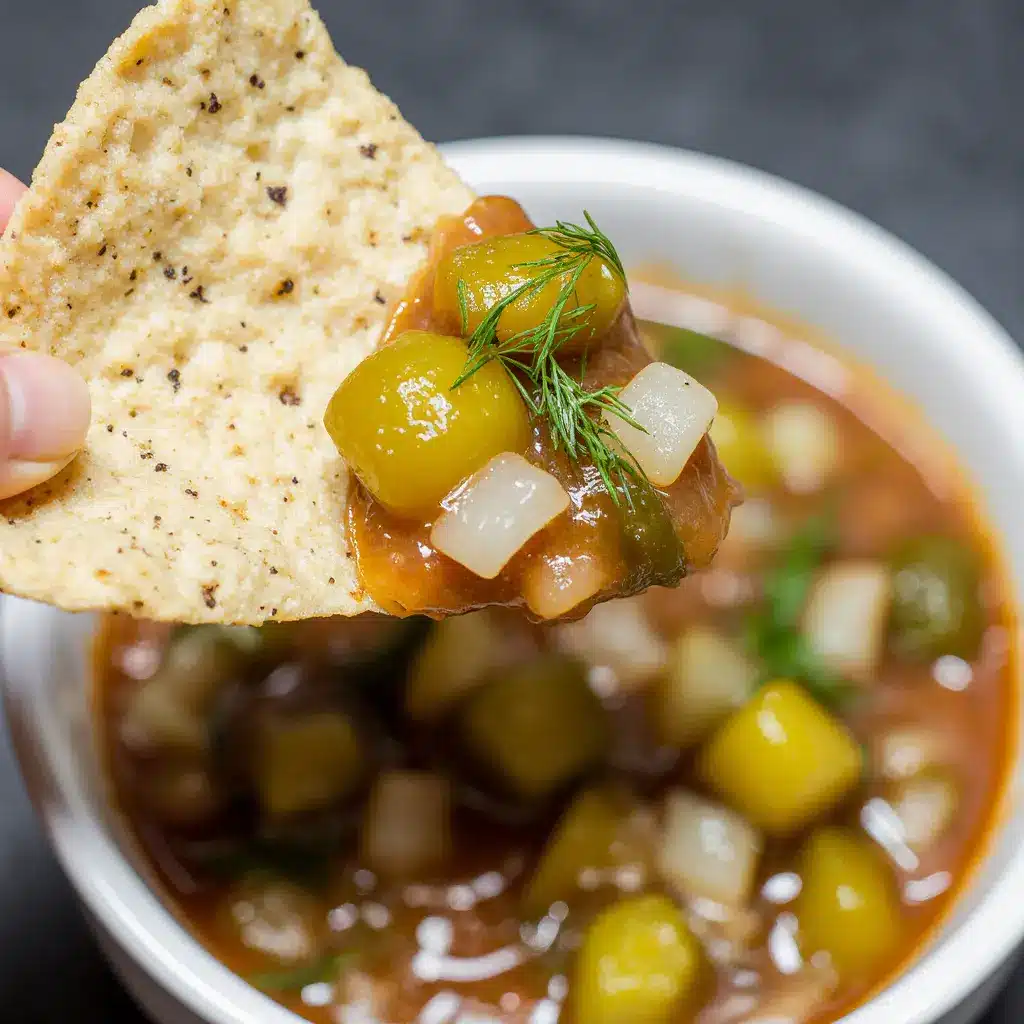






2 thoughts on “Ultimate Pickle de Gallo Recipe: Fresh, Crunchy, and Irresistibly Tangy (2025)”